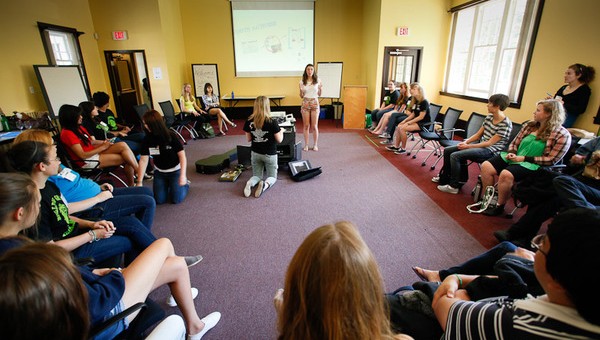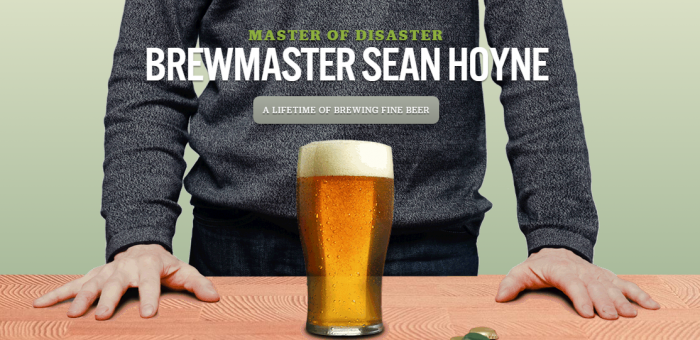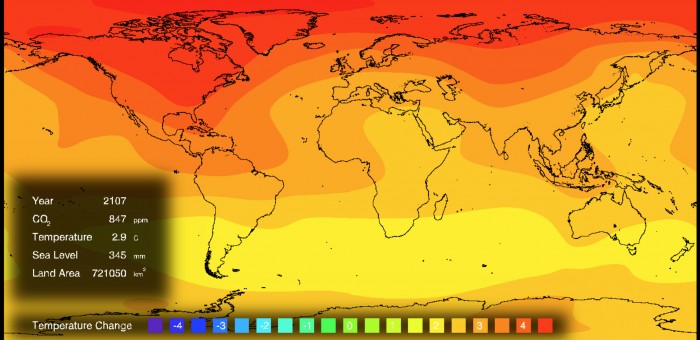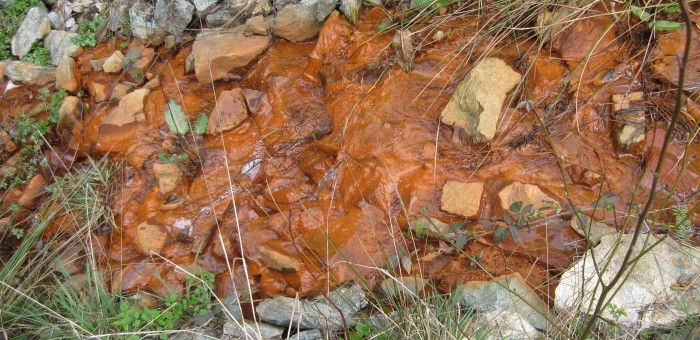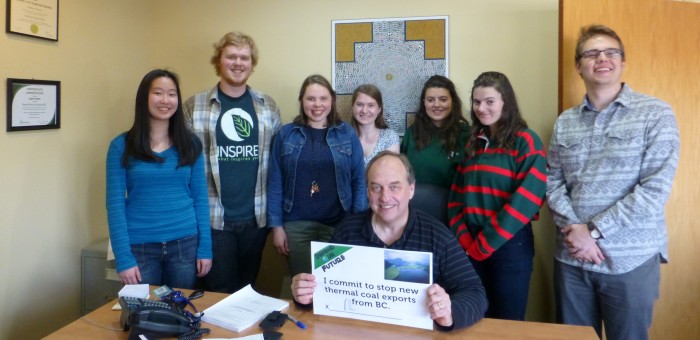Uncategorized
Celebrating youth in our community – Austin Sawyer
This is the 21st in our series of stories celebrating the outstanding accomplishments of youth in our community. These inspirational young adults are enriching our lives with their passion and commitment to the betterment of society.
Austin Sawyer
 This past June Austin Sawyer was one of fifty Canadians awarded the prestigious $80,000 Schulich Leader Scholarship. In Austin’s case, it was his application of the scientific method that led him to rise to the top of the distinguished 2015 class of nominees. Austin joins Alysha Rose as the second Schulich Leader Scholarship winner we have highlighted in our celebrating youth in our community series. And this remarkable young man partnered with fellow Lambrick Park Secondary School student Vicki Kleu (another previously featured student in our series) in the development of method to improve the cleanup and retention of oil spills.
This past June Austin Sawyer was one of fifty Canadians awarded the prestigious $80,000 Schulich Leader Scholarship. In Austin’s case, it was his application of the scientific method that led him to rise to the top of the distinguished 2015 class of nominees. Austin joins Alysha Rose as the second Schulich Leader Scholarship winner we have highlighted in our celebrating youth in our community series. And this remarkable young man partnered with fellow Lambrick Park Secondary School student Vicki Kleu (another previously featured student in our series) in the development of method to improve the cleanup and retention of oil spills.
 His partnership with Vicki was very productive as they shared complementary skill sets with Austin particularly loving the presentation and “making the pitch” component of the science fair competitions. Their project won them national recognition at the 2014 Canada Wide Science Fair and it played a pivotal role in the success of Austin’s Schulich nomination for students who want to study science, technology, engineering and math (academic disciplines known as STEM fields) at a Canadian university. Their science project, a reusable and biodegradable oil boom, won the pair a $500.00 cash prize as well as a Manning Innovation Achievement Award and the Senior Excellence Bronze medal.
His partnership with Vicki was very productive as they shared complementary skill sets with Austin particularly loving the presentation and “making the pitch” component of the science fair competitions. Their project won them national recognition at the 2014 Canada Wide Science Fair and it played a pivotal role in the success of Austin’s Schulich nomination for students who want to study science, technology, engineering and math (academic disciplines known as STEM fields) at a Canadian university. Their science project, a reusable and biodegradable oil boom, won the pair a $500.00 cash prize as well as a Manning Innovation Achievement Award and the Senior Excellence Bronze medal.
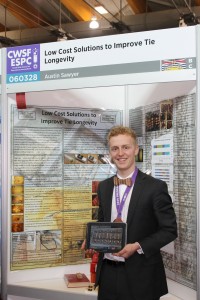 Vicki and Austin’s invention of an inexpensive absorbent boom that picks up over 32ml of oil per gram of fibre was featured in Douglas Magazine earlier this year. And if you’re interested in further details about their impressive findings, check out their TedX Talk entitled A New Approach to Oil Spill Recovery. Austin and Vicki have recently been working with some oil companies to do further research and try to market the oil boom.
Vicki and Austin’s invention of an inexpensive absorbent boom that picks up over 32ml of oil per gram of fibre was featured in Douglas Magazine earlier this year. And if you’re interested in further details about their impressive findings, check out their TedX Talk entitled A New Approach to Oil Spill Recovery. Austin and Vicki have recently been working with some oil companies to do further research and try to market the oil boom.
In 2015 Austin branched off on his own and once again qualified for the national science fair competition, after finishing third in the Vancouver Island Regional Science Fair for his innovative project aimed at developing low-cost solutions to increase the longevity of wood railroad ties. Janet Dawson, a grade eight student at Gordon Head Middle School also mentored by Cheryl Nigh, and coached by Austin, finished fifth and also qualified for the national competition. At the nationals, once again Austin made it to the podium winning won a bronze medal of excellence in the senior category. Janet Dawson for whom he served as a mentor and coach earned a silver medal of excellence in the junior category at nationals, along with wining top discovery project and top astronomy award.
 Austin, now 18 years old, was born in Victoria and attended Torquay Elementary and Gordon Head Middle School prior to graduating from Lambrick Park Secondary this year. We were a little surprised to learn that he disliked science (and school in general) until Grade 8 when he was influenced and inspired by Cheryl Nigh, a talented science and math teacher at Gordon Head Middle School. It was Ms. Nigh who got him interested in science fairs. In Grade 8, Austin entered the regional science fair and ended up winning a Canada wide silver medal of excellence. And Austin has excelled academically ever since he arrived at Lambrick Park Secondary; he obtained a 5.0 GPA every year and a 92% average in Grade 12.
Austin, now 18 years old, was born in Victoria and attended Torquay Elementary and Gordon Head Middle School prior to graduating from Lambrick Park Secondary this year. We were a little surprised to learn that he disliked science (and school in general) until Grade 8 when he was influenced and inspired by Cheryl Nigh, a talented science and math teacher at Gordon Head Middle School. It was Ms. Nigh who got him interested in science fairs. In Grade 8, Austin entered the regional science fair and ended up winning a Canada wide silver medal of excellence. And Austin has excelled academically ever since he arrived at Lambrick Park Secondary; he obtained a 5.0 GPA every year and a 92% average in Grade 12.
 As might be expected, Austin was also involved in a number of extracurricular activities including the Leadership program and the Green Team at Lambrick Park Secondary, as well as its Student Council. He was elected as Vice President of the Student Council (after dressing up as the character Napolean Dynamite during the campaign) and during his tenure he had a liaison role between student council, Leadership and the student body. He loved the role and describes himself as “very social”.
As might be expected, Austin was also involved in a number of extracurricular activities including the Leadership program and the Green Team at Lambrick Park Secondary, as well as its Student Council. He was elected as Vice President of the Student Council (after dressing up as the character Napolean Dynamite during the campaign) and during his tenure he had a liaison role between student council, Leadership and the student body. He loved the role and describes himself as “very social”.
To be nominated for the Schulich Award, Austin had to submit an essay to the Principal and Vice Principal of his school to explain “how being an all around student was more important than strictly grades”. Then he wrote an essay to the Schulich Board based on the following quote by David Suzuki about future and continued fossil fuel extraction: “We’re in a giant car heading towards a brick wall and everyone’s arguing over where they are going to sit”. Austin envisions a future “where the car is being driven away from the wall toward change and leaving the world a better place”.
 In ten years, Austin would like to own a biomedical company and design prosthetics to help people with physical disabilities. In September, he will begin his studies at the University of Victoria in engineering, with a focus on chemical or biomedical engineering in the future.
In ten years, Austin would like to own a biomedical company and design prosthetics to help people with physical disabilities. In September, he will begin his studies at the University of Victoria in engineering, with a focus on chemical or biomedical engineering in the future.
Austin also excels in sports. He started playing soccer at age 8 and admits to being “very competitive”. He scored the winning goal in a shootout in Grade 11, while playing for his soccer club Saanich Fusion (Gold Level). He also ran track in Grade 9, 10 and 11, including relay and 100 metre events. In Grade 12, he was sidelined with an ankle injury and bone issue that required surgery. Back in form now, he likes to go running, hiking and play soccer for fun.
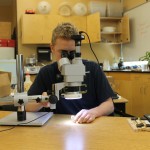 Austin has a job at Berwick House, a retirement residence in Victoria where he works with his brother in the kitchen. He enjoys interacting with the seniors and loves to hear their stories. He has been a volunteer in the community at marathons, at the Campus View elementary craft fair and as a mentor to younger students at the Science Fair. He loves mentoring students and brings his tremendous enthusiasm to the role.
Austin has a job at Berwick House, a retirement residence in Victoria where he works with his brother in the kitchen. He enjoys interacting with the seniors and loves to hear their stories. He has been a volunteer in the community at marathons, at the Campus View elementary craft fair and as a mentor to younger students at the Science Fair. He loves mentoring students and brings his tremendous enthusiasm to the role.
This very well rounded young man has clear goals, an engaging personality and a brilliant future. Those young students he mentors in science fairs are fortunate indeed to know Austin.
Celebrating Local Businesses in Our Community – Hoyne Brewing Company
This is the fourth in our series highlighting innovation and creativity within our region’s business sector.
It was sweltering hot and the brewery was buzzing the afternoon we met with Sean Hoyne. As people filtered through filling growlers with their favourite beer we asked Sean to tell us about his brewery and how they got started. Though the Hoyne Brewing Company has only been open for three and a half years, Sean started their story in the 1970s – before commercial craft brewing had even begun in Canada.
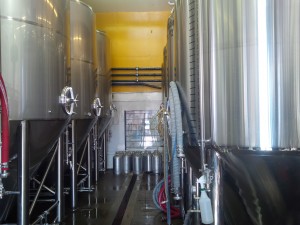 Frank Appleton, who Sean credits as the father of the craft beer movement in British Columbia, was a quality control supervisor at Carling O’Keefe’s but he had grown tired of the corporate beer scene and decided to quit in 1972. He spent the 1970s and 80s writing articles for the Harrowsmith magazine while brewing beer at his home in Edgewood, B.C. One of those articles, about the joys of home-brewing, caught the eye of John Mitchell who, at the time, was the co-owner and manager of the Troller Ale House in Horseshoe Bay.
Frank Appleton, who Sean credits as the father of the craft beer movement in British Columbia, was a quality control supervisor at Carling O’Keefe’s but he had grown tired of the corporate beer scene and decided to quit in 1972. He spent the 1970s and 80s writing articles for the Harrowsmith magazine while brewing beer at his home in Edgewood, B.C. One of those articles, about the joys of home-brewing, caught the eye of John Mitchell who, at the time, was the co-owner and manager of the Troller Ale House in Horseshoe Bay.
Mitchell had grown up in pub-rich England and was frustrated by the limited selection of beer in Canada. He tracked down Appleton and asked him if he would help him start a brewpub, a pub where good beer was both brewed and served. Far easier said than done at the best of times, Mitchell and Appleton first had to convince the local and federal governments to pass legislation that would make brewpubs legal. Previously, provincial law prohibited the public sale of beer at breweries but in 1981, after many meetings and rounds of legislation, they got approval to start brewing – and selling – their own beer from a single establishment (with the caveat that a commercial road separated the brewery and pub). Mitchell and Appleton opened Horseshoe Bay Brewery with a little store across the street on the waterfront, the first brewpub to open in North America since prohibition. From there, Mitchell and Appleton went on to open Spinnakers, Canada’s first in-house brewpub, and help dozens of other local breweries get started.
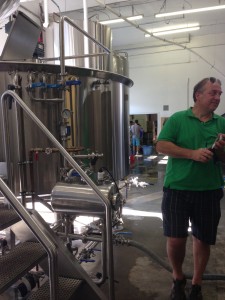 Sean enters this story, homebrewed six-pack in hand, in the late 1980s. He had a science degree to back up his beer brewing passion and he was keen to learn everything Appleton could teach him. He brought a case of homemade beer to his job interview with Appleton and let the beer speak for itself while they talked literature. Sean got the job and the two of them went on to set up the brewery in Swans Hotel in 1989. After a few years in the brewmaster role at Swans, Sean left to build the brewery at Canoe Brewpub. “I brewed there for 13 years, focusing on developing award-winning beers and fostering a sense of community between brewers and beer enthusiasts,” he said of his time at Canoe.
Sean enters this story, homebrewed six-pack in hand, in the late 1980s. He had a science degree to back up his beer brewing passion and he was keen to learn everything Appleton could teach him. He brought a case of homemade beer to his job interview with Appleton and let the beer speak for itself while they talked literature. Sean got the job and the two of them went on to set up the brewery in Swans Hotel in 1989. After a few years in the brewmaster role at Swans, Sean left to build the brewery at Canoe Brewpub. “I brewed there for 13 years, focusing on developing award-winning beers and fostering a sense of community between brewers and beer enthusiasts,” he said of his time at Canoe.
Ready to start a new chapter in a sector that was enjoying incredible public support, Sean moved into a space just outside of downtown Victoria and started to build the Hoyne Brewing Company. Starting with a team of one (himself), Sean is now one of 20 working at the brewery. In addition to serving liquor stores and customers who come into the brewery, Hoyne sells directly to bars and restaurants. They do their own deliveries, he explained, so they can provide the best service possible – even when their bottom line would recommend doing otherwise. They have partnered with Geazone, a local zero-emissions delivery service that uses electric cars and bike courriers, for their distribution. It costs more, said Sean, “but I like supporting Andrew, [Geazone’s president and CEO], because he is a young entrepreneur doing the right thing.” They even do their Victoria to Vancouver run with the zero-emissions fleet. Sean ensures two people are on each delivery run so they can share the job and help with the loading and rearranging of kegs in their drop-point’s cold room. It may seem like a simple gesture, but one that I’m sure is greatly appreciated by servers sent down to switch heavy kegs during rush hours. “We do what we can to support other businesses,” said Sean.
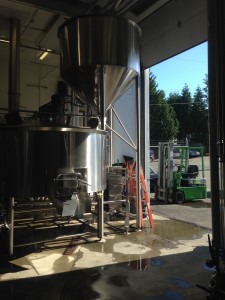 A central part of Hoyne’s mandate is to help wherever they can. It is a value system that has triggered countless positive ripple effects, both locally and abroad. They support charities (financially or with beer, where appropriate), including the Dirty Walls Project in India and source their equipment, hops, and malt from within B.C. The shiny stainless steel tanks found throughout the brewery were made on Vancouver Island and twice as expensive as their foreign-made counterparts, but the connections and collaborative friendships the brewery has made supporting local workers has made it more than worthwhile, said Sean. “If something is wrong with the tanks, they’ll be here at a moment’s notice to help out.” Local farmers are often at the brewery too, picking up loads of spent grain for their animals and gardens.
A central part of Hoyne’s mandate is to help wherever they can. It is a value system that has triggered countless positive ripple effects, both locally and abroad. They support charities (financially or with beer, where appropriate), including the Dirty Walls Project in India and source their equipment, hops, and malt from within B.C. The shiny stainless steel tanks found throughout the brewery were made on Vancouver Island and twice as expensive as their foreign-made counterparts, but the connections and collaborative friendships the brewery has made supporting local workers has made it more than worthwhile, said Sean. “If something is wrong with the tanks, they’ll be here at a moment’s notice to help out.” Local farmers are often at the brewery too, picking up loads of spent grain for their animals and gardens.
Comparing the rise of local craft breweries in B.C. with mega breweries like Molson that are now all run by non-Canadian owners (with the exception of Pacific Western), Sean attributes craft’s success with the sector’s determination to deviate from the mass-production business model. “Local craft breweries have social license,” said Sean. “They are involved in the community, transparent, open to the public, and authentic. I am in this industry because I like beer, to me it represents enjoyment and community.”
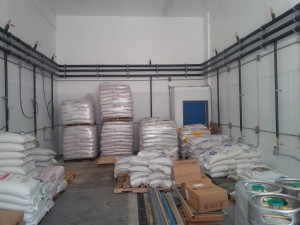 “People are always welcome to stop by our brewery,” Sean continued, “and every ingredient is listed on our bottles. We are proud of that.” As beer is not considered a ‘food product’ by the Canadian Food Inspection Agency, ingredient lists are not a requirement. Mass-produced beers, Sean explained, contain preservatives – which he stressed are not necessary unless you are selling old beer. “[At Hoyne] we don’t deliver our beer past where we can ensure it will arrive fresh so we don’t have to add anything extra, like preservatives. You can do things differently.”
“People are always welcome to stop by our brewery,” Sean continued, “and every ingredient is listed on our bottles. We are proud of that.” As beer is not considered a ‘food product’ by the Canadian Food Inspection Agency, ingredient lists are not a requirement. Mass-produced beers, Sean explained, contain preservatives – which he stressed are not necessary unless you are selling old beer. “[At Hoyne] we don’t deliver our beer past where we can ensure it will arrive fresh so we don’t have to add anything extra, like preservatives. You can do things differently.”
Sean and his team have made numerous adjustments to the status quo, from allowing their beer to naturally carbonate during the fermentation process (instead of releasing the CO2 and force-carbonating the beverage further along the production line) to building a glycol refrigeration system that allows them to cool individual tanks instead of the entire room.
As an enthusiastic supporter of the entire local craft beer sector, it was a pleasure to see the process in action and learn more about Hoyne’s community-based business model. Though I opted out of the taste-testing portion of my visit, because I was driving and had a CBC interview immediately afterwards, I already knew from experience that Hoyne’s Devil’s Dream IPA is one of my favourites.
Tempering expectations ahead of the 2015 Paris global warming summit
From November 30 to December 11, 2015, world leaders will gather in Paris in an attempt once more to negotiate an international treaty to reduce greenhouse gas emissions and hence global warming. Below I provide my thoughts in the lead up to this international convention.
Since the establishment of the United Nations Framework Convention on Climate Change (UNFCCC) in 1992 that came into force in 1994 and is now ratified by 195 nations, there have been twenty Conferences of Parties. There are high expectations that the upcoming twenty-first Conference of Parties (COP21) in Paris later this year will deliver an international agreement that will allow the UNFCCC to attain its objective of “stabilization of greenhouse gas concentrations in the atmosphere at a level that would prevent dangerous anthropogenic interference with the climate system.”
But this is not the first time high expectations have preceded and subsequently followed a COP. In 1997 at COP3 the Kyoto Protocol to the UNFCCC was adopted wherein Annex I nations agreed to reduce greenhouse gas emissions to 5% below 1990 levels on average by 2008-2012. While the Kyoto Protocol came into force in 2005, the lack of its binding nature, combined with Canada formally pulling out of the agreement in 2012 and the United States never ratifying it, watered down its effectiveness.
Similarly, expectations leading up to COP15 in Copenhagen were almost euphoric that a post Kyoto agreement would be reached. In the end COP15 was a disappointment. The so-called Copenhagen Accord, taken note of, as opposed to being agreed to, by the Conference of Parties outlined a loose set of aspirational goals supported by 114 nations. As part of the Copenhagen Accord, countries submitted voluntary reduction targets with the aim of holding the global temperature increase to less than 2°C. But as noted by, Rogelj (2010) if countries actually met their non-binding targets, it would be virtually certain that warming would exceed this amount. The disconnect between science and international policy is clearly quite profound.
Whether or not society chooses to take the necessary steps to mitigate climate change ultimately depends on the extent to which we value the importance of intergenerational equity. Ultimately and collectively we must ask ourselves whether or not we believe that future generations are entitled to the same environmental well-being and biodiversity that has been afforded our generation. What is clear from our scientific understanding of global warming is that the decisions being made today will have profound consequences for generations to come; yet future generations are not part of today’s decision making and today’s decision makers won’t have to live the consequences of the decisions they make.
Science can never be used to answer a question concerning the importance of intergenerational equity nor can it ever be used to prescribe a particular policy. However, science is able to examine the implications of various policy options. Policy can also be developed or modified to reflect the latest science. But in the end, the formulation of policy requires engaging a variety of stakeholders including special interests, religious groups, and industry. It also requires dealing with ethical, political, legal, financial and social issues including any potential application of the precautionary principle.
One thing that seems clear is that the nonbinding international climate treaty process to date has been a colossal failure. The negotiations have played out like a textbook example of the tragedy of the commons. It is in every person’s best financial interest to do absolutely nothing about greenhouse gas mitigation since the cost of action is borne by the individual yet the cost of inaction is distributed amongst billions of people in the generations to come.
Perhaps as we move forward with the COP process a more useful role for the United Nations at this juncture would be to attempt to reach agreement on an internationally acceptable price trajectory for carbon emissions. Such carbon pricing might include provisions that allow carbon tariffs to be added to imports from nations that have not implemented a domestic carbon pricing policy. For without global efforts to ensure the internalization of externalities associated with these emissions, it seems unlikely that announcing more non-binding aspirational reduction targets will be an effective mitigative tool. We’ve had more than two decades of evidence that this process has not worked.
Here science can be helpful in informing international pricing discussions by recognizing that warming responds near-linearly to cumulative carbon emissions. This allows for the calculation of the allowable emissions required to ensure future warming is below some specified (say 2°C) level (Weaver 2008; Allen et al., 2009; Meinshausen et al., 2009; Zickfeld et al., 2009).
Whether or not such discussions take place of course relies upon political will. The barriers to introducing climate change policy that would ensure a sustainable future are neither technological nor behavioural. They are almost purely political. For until such time as our elected leaders recognize and subsequently act upon the knowledge that the long-term climatic impacts of their decisions, or more appropriately lack thereof, are very serious, we see little prospect of meaningful international agreements being reached through the UNFCCC process.
Soils in the Shawnigan Lake Watershed — Some Questions
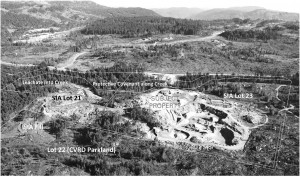 Earlier this month I wrote a piece on the wisdom of dumping contaminated soils in the Shawnigan Lake watershed. I visited the region with Shawnigan Lake Area Director Sonia Furstenau. Together with a few other Shawnigan Lake residents, we hiked around on parkland owned by the Cowichan Valley Regional District. I took this opportunity to take a number of photographs. More importantly, I took the opportunity to collect water samples.
Earlier this month I wrote a piece on the wisdom of dumping contaminated soils in the Shawnigan Lake watershed. I visited the region with Shawnigan Lake Area Director Sonia Furstenau. Together with a few other Shawnigan Lake residents, we hiked around on parkland owned by the Cowichan Valley Regional District. I took this opportunity to take a number of photographs. More importantly, I took the opportunity to collect water samples.
The results of these water samples, together with my observation that a significant amount of fill had over run Lot 21 and was on the neighbouring parkland, led me to ask the Minister of Energy and Mines and the Minister of Environment questions in Question Period today.
Below are the questions and the Ministers’ responses. I gave the Ministers my questions in advance as I wanted to give them time to check with staff prior to providing answers. The answers I received in my view are very helpful in providing information to the CVRD as to how they might proceed.
Question
A. Weaver: I have in my possession two letters [here and here] sent from the Ministry of Energy and Mines to South Island Aggregates in Shawnigan Lake concerning “sloughing or material that encroached onto Cowichan Valley regional district property.”
The April 1, 2014 letter from the ministry’s regional manager for the coast area states that “the property impacted by the encroachment must be cleaned up and returned to its pre-encroachment state to the satisfaction of the property owner.”
The story continues. I also have a letter from the CVRD clearly outlining the fact that the property impacted has yet to be cleaned up, let alone to the CVRD’s satisfaction. South Island Aggregates needs an amendment to its mines permit before its Ministry of Environment permit can become active.
Will the Minister of Energy and Mines commit to ensuring that before an amended permit is issued, the infractions and issues of non-compliance at this site have been addressed?
Answer
Hon. B. Bennett: It’s actually refreshing to get a question where the member has a good grasp of the facts. I don’t think that this quarry is in the member’s riding so, honestly, he deserves a lot of credit for having done the due diligence that whoever the MLA is for that area hasn’t done.
To the member’s question, he is correct that there was a commitment made by the Ministry of Energy and Mines that we would ensure that the company that had encroached on regional district land would, in fact, remediate that land. An engineering plan has gone to the regional district, about eight weeks ago.
I don’t know why we haven’t heard back from the regional district, but I will commit to work with the member, work with our ministry, work with the regional district and make sure that they know they have that plan. They can take some time to look at that plan, and that RD land will be remediated.
Supplementary Question
A. Weaver: Thank you to the minister for the answer.
For several years soil has been dumped in lot 21 for later use as backfill for the neighbouring quarry in lot 23, which we just discussed, where the amended permit is required. I recently visited the location. I collected and subsequently analyzed water samples and noted that runoff from this site entering Shawnigan Creek had extremely high iron levels that failed drinking water standards locally.
The Cowichan Valley regional district is very concerned about the long-term safety of drinking water in the Shawnigan Lake area. They want to conduct an independent environmental investigation of lots 21 and 23 and are willing to pay the costs of doing so themselves. There will be no expense to the government.
My question to the Minister of Environment is this. Does the CVRD require a contractual agreement with the ministry to allow them to conduct such an investigation? If so, will the ministry consider entering into such an agreement? If not, is it the minister’s understanding that the CVRD have full authority to conduct such an independent environmental investigation on lots 21 and 23?
Answer
Hon. M. Polak: Thank you to the member for providing some details ahead of time. That enabled me to pursue and seek some advice with respect to jurisdictional issues around environmental testing.
Here’s what I can tell the member. With respect to lot 21, it is private property. Now, that means for the Ministry of Environment that we have full authority to be able to enter that property, conduct testing, investigate if there are concerns with respect to pollution. We intend to do so. We have done so, and I will talk a little bit more about that in a moment.
There is, however, though, no authority — the minister possesses no authority — to be able to allow another party, even through a contractual arrangement, to engage in that kind of investigation on private land. Here’s what we can do, though. Staff, after meeting with representatives from CVRD have developed a sampling plan for the site. I understand they will be discussing that with CVRD today.
We cannot order the private property owner to allow CVRD members to attend and observe. However, we will be discussing that with them, and we’re hopeful that on a voluntarily basis the landowner will allow us to bring along CVRD representatives to observe the testing. In the absence of that we will certainly make sure that all test results, all test processes are discussed and shared with the CVRD.
Video from Question Period
Defend Our Future Rally at OBGH MLA Office
On April 8th, a group of well-informed and passionate young people gathered at the Oak Bay-Gordon Head MLA Constituency Office as part of the Defend Our Future BC Day of Action on Climate Change. This was one of 23 meetings organized at MLA offices in 12 cities across BC. The purpose of the meeting was for the youth to express their opposition to the expansion of thermal coal exports from BC. They voiced their concern about the Port Metro Vancouver proposal to increase exports of American thermal coal through the Fraser-Surrey Docks coal transfer facility and through the Texada Island facility by 8 million tons annually and the risk to the health and well-being of communities in proximity to rail lines, port facilities and power plants.
Each of the youth in attendance spoke about why they came to the meeting and how they expect their elected leaders to defend their future. They spoke of the need to reduce the use of thermal coal as a means of producing electricity and the need to develop renewable energy sources to mitigate global climate change. It was inspiring to hear from these young people as they led the dialogue about issues that matter to them, their future and the future for generations to come.

